Anglers Booking Team
The expert copywriters at Anglers Booking have meticulously crafted this article. Our dedicated team of writers provides valuable insights and information to enhance your angling experience.
 13 minutes read
13 minutes readMarlin fishing stands at the pinnacle of saltwater angling. These ocean giants embody both power and spectacle, known for their incredible speed and strength. The Striped Marlin can reach blistering speeds of up to 50 mph, placing it among the fastest fish in the world.
Black and Blue Marlins are not far behind. Their explosive runs leave most predators in their wake, and their unmatched strength is what truly defines them.
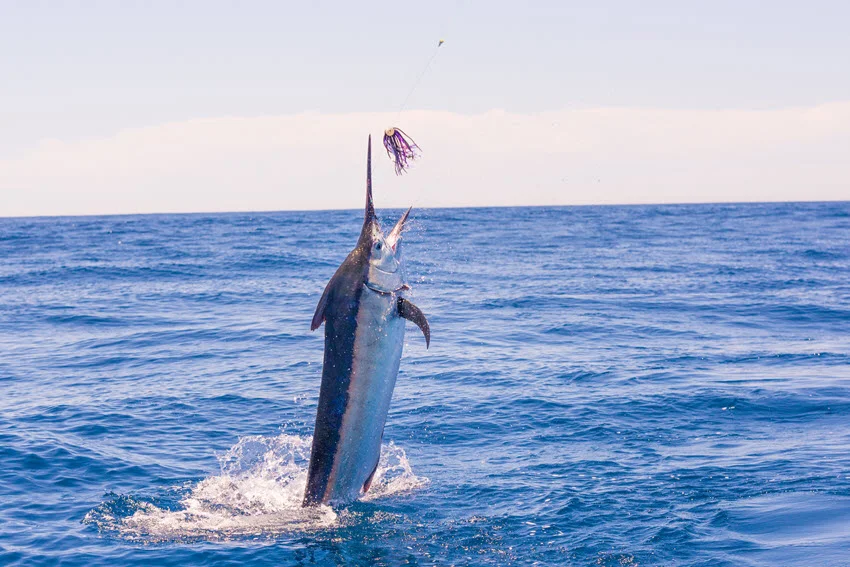
The moment a Marlin takes the bait, the real show begins. The fight is pure adrenaline. Every leap, twist, and dive shows these fish's power. For many anglers, landing a Marlin is not just a catch – it is a story that gets retold for years.
In this guide, you will find all the essential information about Marlin fishing. You will learn exactly what gear to use, the best times to fish, and how to choose the right bait for Marlin.
There are several types of Marlin, and fishing for each one offers a unique experience. Spotting the differences between these giants is important. In the sections below, we will break down the most sought-after types of Marlin.
We will explore their key characteristics, show you what they look like, and reveal their typical size and lifespan. And of course, there is much more to discover as you read on.

The Blue Marlin is one of the world's iconic big game fish. While males rarely exceed 300 pounds, females can grow up to 1,800 pounds and reach lengths of over 16 feet. Most recreationally caught fish, however, fall between 200 and 500 pounds. Blue Marlin can live up to 27 years, and females usually outlive males.hg
The best time to catch it depends on the region. In the Atlantic, peak season runs from June to October. Pacific hotspots like Hawaii and Mexico see the best action between May and September. Blue Marlin prefer depths ranging from 300 to 600 feet.
Blue Marlin are apex predators that feed primarily on Mackerel, Tuna, and other pelagic species. They slash through bait schools with their bills before returning to feed.

Black Marlin are powerhouses, capable of extreme endurance. In length, they can grow up to 15 feet. Their weight can be over 1,600 pounds. However, most fish caught on rods and reels range between 300 and 1,200 pounds. Black Marlin typically have a lifespan of around 12 to 15 years.
They are most commonly caught from September through December in Australia, particularly along the Great Barrier Reef. The period from November to April is the best in Panama and Central America. These fish prefer warmer tropical waters. They are frequently found in depths between 100 and 500 feet, often near drop-offs and reefs.
Black Marlin prey on large baitfish like Bonito, Yellowfin Tuna, Mahi Mahi, and flying fish. They're ambush predators that rely on short, powerful runs to overpower their prey, making live bait and large trolling lures particularly effective.
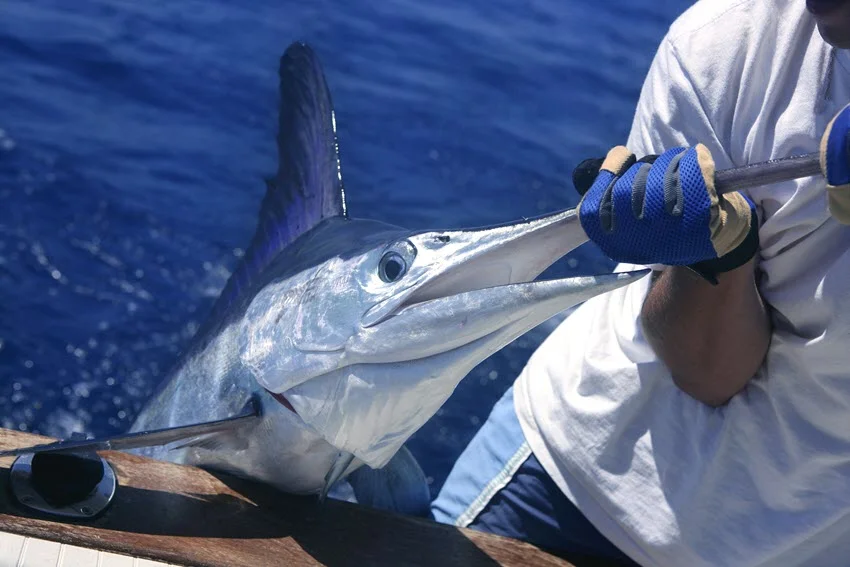
White Marlin are the smallest members of the Marlin family. What they lack in size, they make up for in speed and elusiveness. Most White Marlin measure around 5 to 8 feet. Their average weight is between 50 and 100 pounds, and the maximum recorded weight is about 220 pounds. Their average lifespan is roughly 10 years.
They are typically targeted from June through September in the western Atlantic, particularly off the U.S. East Coast, the Gulf of Mexico, and the Caribbean. White Marlin favor water depths from 100 to 600 feet. It is often near underwater structures or current lines where baitfish congregate.
White Marlin hunts by overtaking their prey rather than slashing with their bill. Their diet includes squid, sardines, and small pelagic fish. Because of their selective feeding and erratic movement, rigged baits and small trolling lures often yield the best results.

Striped Marlin are well-known for their stunning displays and long, high-speed runs. They typically weigh between 120 and 250 pounds, some exceeding 400 pounds. Their average length ranges from 6.5 to 10 feet, and they can live up to 10 to 12 years.
Striped Marlin favor cooler waters in the Pacific, often migrating with the seasons. Prime fishing periods include November to March off Baja California and New Zealand. December to May is the best time to visit Ecuador and Peru. These fish are often found in surface waters but can dive as deep as 300 feet when hunting.
Their diet consists primarily of Sardines, anchovies, squid, and Mackerel. They are aggressive feeders and often strike small, flashy lures trolled quickly across the surface, mimicking schools of baitfish.
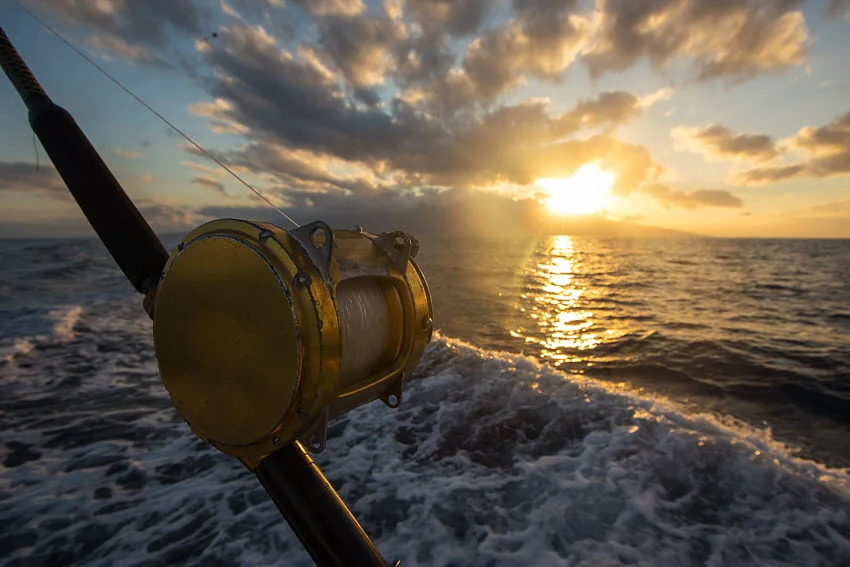
Timing is crucial when it comes to Marlin fishing. Understanding seasonal patterns, the best times of day, and the influence of tides and water movement can make a big difference in your success. Below, we break down the key factors. This analysis will help you plan your Marlin fishing adventures more effectively.
Spring is the beginning of the Marlin migrations in many regions. As water temperatures rise, Marlins become more active. In the Pacific, areas like Mexico's Pacific coast see increased Marlin activity during this period.
Summer is considered the peak season for Marlin fishing. Warm waters attract species like Blue Marlin. During this period, they are more abundant in areas such as the Caribbean and the Pacific.
Fall continues to offer excellent Marlin fishing opportunities. In regions like the Caribbean and parts of Florida waters, Marlins remain active. They tend to feed vigorously before migrating to warmer waters.
During winter, Marlin activity slows in some areas. Still, regions like the Caribbean offer opportunities to catch Marlins. They are more abundant in these warmer waters during this season.
Marlins are most active during specific times of the day. Early morning, sunrise, and late afternoon are the best times to target Marlin. Additionally, evening hours can also yield successful catches.
Tidal movements have a substantial impact on Marlin feeding behavior. Tidal changes — especially during full and new moon phases — create stronger currents that bring nutrient-rich waters to the surface. This attracts baitfish, which in turn draws in Marlin. Fishing during these tidal changes can significantly increase your chances of landing one.
It is crucial to choose the correct location for Marlin hunting. Fishing for this fish is popular in many places around the world. So, considering the number of these places, it was not easy to choose the one that will make you the most successful in fishing. After analysis, we have selected some of them for you. Let's go to the next part!

Vitoria is located in the state of Espírito Santo, Brazil. This location is famous for being where the world record for Blue Marlin was set back in 1992.
The prime Marlin fishing season in Vitoria runs from October to March, aligning with the Brazilian summer months. During this period, the warm waters and nutrient-rich currents attract large populations of Blue Marlin. It offers anglers optimal conditions for successful fishing expeditions.
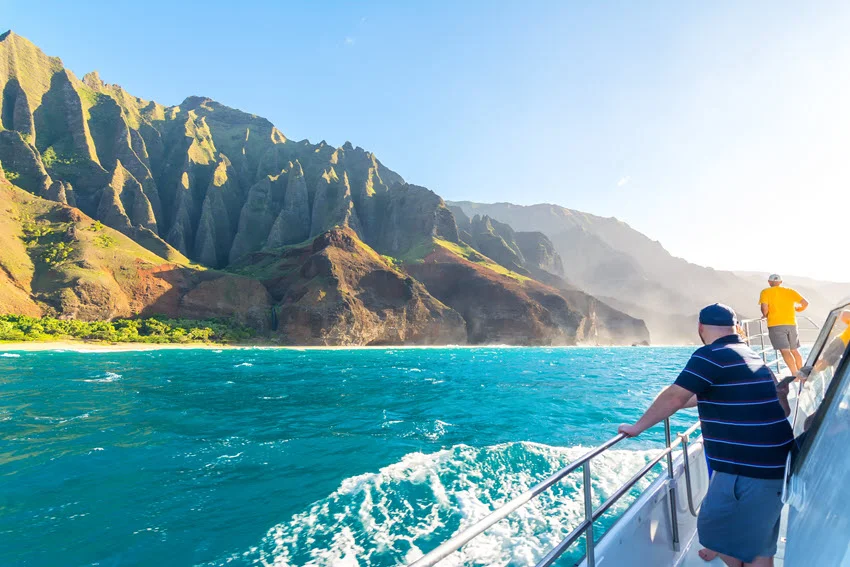
Kona, on the Big Island of Hawaii, is famous worldwide for its Marlin fishing. Fishing for Blue Marlin is especially popular here. The best time to fish for Blue Marlin is from June to October. Kona is renowned for producing many "grandees" – Marlin weighing over 1,000 pounds.
This place offers some of the best fishing experiences in the world, featuring top captains and ideal conditions. Don't miss the Hawaiian International Billfish Tournament in August for intense fishing action.

Cozumel and Cancun in Mexico are prime spots for Marlin fishing. The prime time for Marlin fishing here is from late March to July. You can target Blue and White Marlin and other Billfish species during this period.
While the Blue Marlins in this region tend to be smaller than those in the Pacific, they are known for their athleticism. It provides an exciting challenge for anglers.

Cabo San Lucas is one of Mexico's top destinations for Marlin fishing. It is especially popular among anglers chasing trophy catches. The peak season runs from late spring through early fall.
September and October are the most productive months. Blue and Black Marlin are commonly caught here. This is the main reason why Cabo is a favorite spot for those seeking large specimens.

Puerto Vallarta is another prime location in Mexico for Marlin fishing, known for producing some of the country's biggest catches. Offshore structures such as Corbetana Rock and El Banco are hotspots where some of the largest Black Marlins roam.
The best time to fish here is also from September to October, when Marlin activity peaks and conditions are ideal for offshore action.
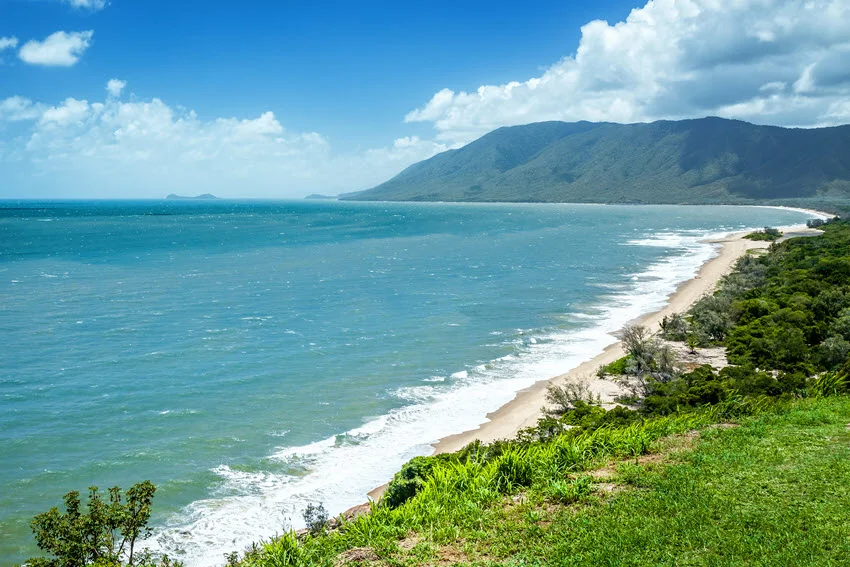
Cairns, located on the Great Barrier Reef, is known as the Marlin capital of the world. It attracts anglers from around the globe in search of giant Black Marlin. The peak season runs from September to December, when large fish gather along the reef to spawn.
The Great Barrier Reef is the only confirmed breeding ground for Black Marlin. This makes Cairns a legendary destination for anglers seeking unforgettable big-game fishing experiences.
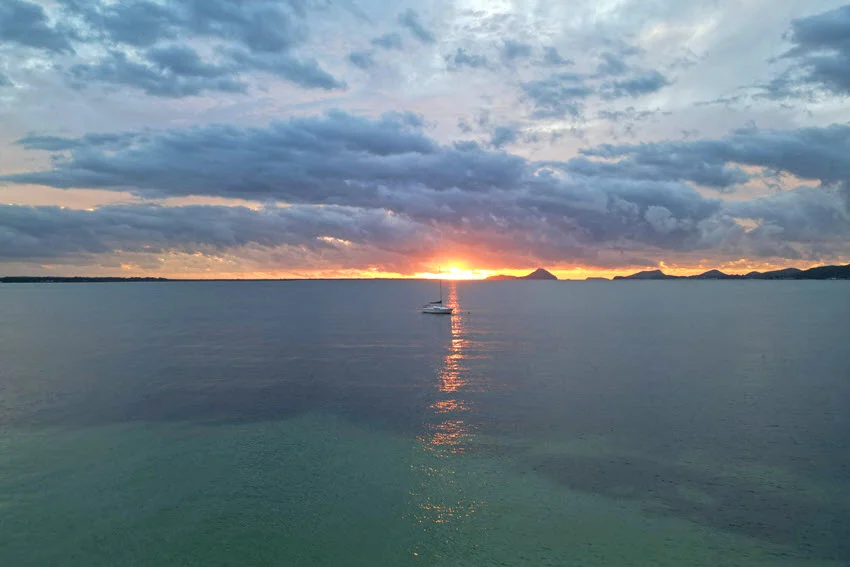
Port Stephens is located on the east coast of Australia. Its offshore waters attract both Black and Striped Marlin, offering world-class action for anglers of all experience levels. The season typically runs from September to March.
The area is also famous for hosting the Port Stephens Interclub, one of the largest billfish tournaments in the Southern Hemisphere. This event highlights why Port Stephens remains a must-visit destination for dedicated big-game anglers.
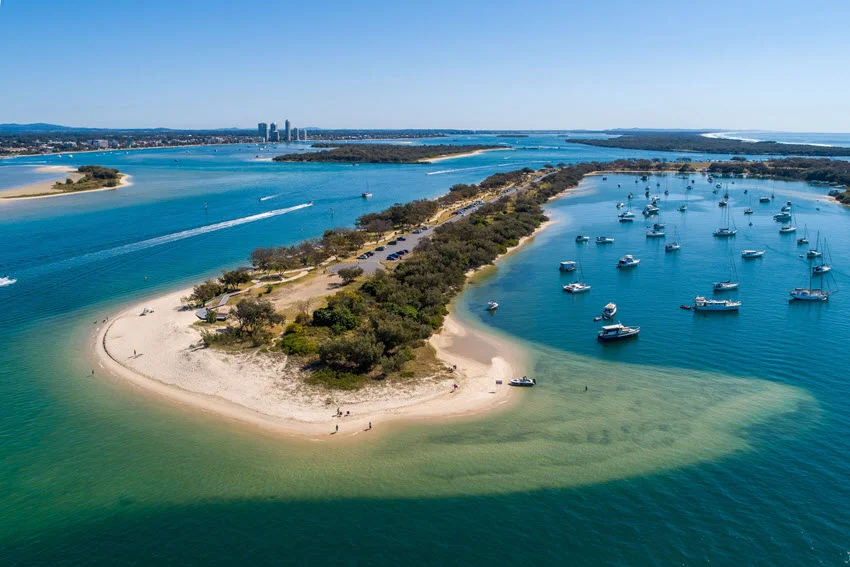
The Gold Coast, particularly around Main Beach, offers some of the most consistent Marlin fishing in Australia. Blue and Black Marlin are the primary targets here. They are often found close to deep drop-offs just a few miles offshore. The season typically peaks from November to February.
This stretch of coastline is known for both quality and quantity, making it a prime destination for anglers seeking steady action and impressive catches in tropical conditions.

Vanuatu, an island nation in the South Pacific, is a paradise for Blue, Black, and Striped Marlin. The clear, deep waters around the islands provide year-round opportunities, with the best fishing taking place from May to November. Strong ocean currents and abundant bait make these waters ideal for trolling.
Black and Striped Marlin are especially common from August to November, drawing anglers from across the Pacific for thrilling offshore battles and spectacular strikes.

Florida's proximity to the Gulf Stream makes it one of the most accessible Marlin destinations in the United States. Blue Marlin are most active from April through July, especially off Key West and Miami, where deep blue waters lie just offshore.
While White Marlin are more common farther north, Florida's southern coast remains a favorite for anglers looking to test their skills against fast and powerful Blue Marlin in warm Atlantic waters.

Ocean City is known as the White Marlin capital of the world, attracting thousands of anglers each summer. The best time to fish here is from mid-July to September, when warm Gulf Stream waters push close to the coast.
Many anglers target the "Jack Spot," about 22 miles offshore, where Marlin are frequently caught. The city also hosts the world-famous White Marlin Open every August, one of the most prestigious billfish tournaments in the world.

Piñas Bay, on Panama's Pacific coast, offers some of the best year-round Marlin fishing in the world. Both Blue and Black Marlin thrive in these nutrient-rich waters, where deep currents and abundant bait create ideal conditions.
The area is home to the famous Tropic Star Lodge, known for producing record catches. This location is considered one of the top spots in the Western Hemisphere for targeting massive Black Marlin.

The southern Pacific coast of Costa Rica, around Jaco and Quepos, provides excellent action for Blue and Black Marlin. The peak season runs from August to December, when calm seas and warm waters draw large numbers of billfish close to shore.
Productive reefs and offshore drop-offs make this region one of Central America's most reliable destinations for anglers chasing powerful Marlin in stunning tropical surroundings.

On Costa Rica's northern Pacific coast, Playa Flamingo and Tamarindo are among the best places to target Marlin. The prime months are November through March, when Blue and Black Marlin are most active.
Fishing charters in this area are known for consistent results and expert crews, offering anglers a perfect mix of scenic beauty and world-class big-game action.

New Zealand's Bay of Islands, Waihau Bay, and Cape Runaway are renowned for exceptional Striped Marlin fishing. The peak season runs from December to March, when large schools of baitfish attract these powerful predators close to the coast.
Average catches range from 300 to 500 pounds, and the thrilling surface strikes make New Zealand one of the most exciting destinations for anglers seeking Striped Marlin.
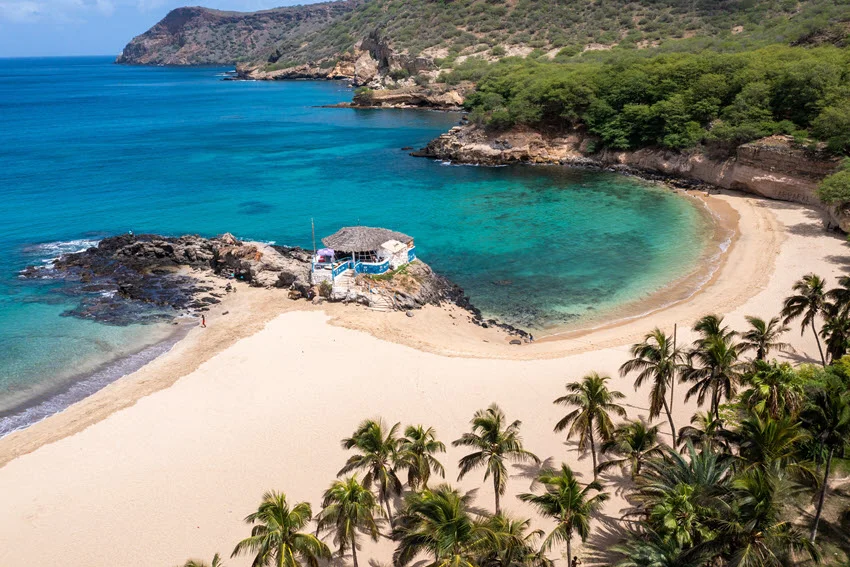
Cape Verde is off the west coast of Africa. It is becoming a popular Marlin fishing destination. Blue Marlin are common here from August to December.
Anglers can expect to catch large and small fish. The best time to visit for Marlin fishing is during these peak months. During this period, the waters are rich with Marlin.
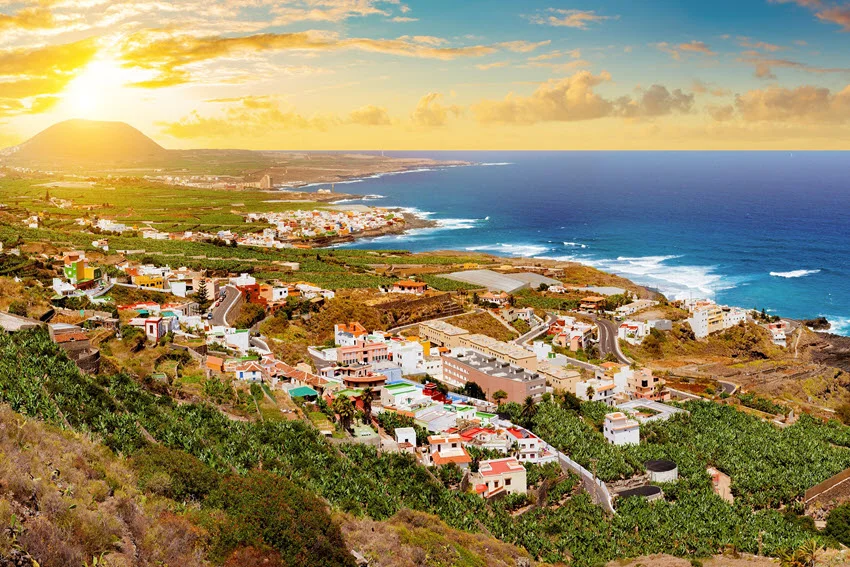
Another great place to fish for Marlin is the Canary Islands. They are located off the coast of northwest Spain. From May to October is the best time to fish for this fish. Fishing for Blue Marlin is especially popular here.
The reason is that this region is home to some huge specimens of this species. Their average weight ranges from 400 to 600 pounds. If you are interested in charter fishing, you can find it on Tenerife, Lanzarote, and Fuerteventura.

Madeira, located in the Atlantic Ocean, is famous for its calm seas and deep waters close to shore. Perfect conditions for targeting Blue and White Marlin. The best fishing season runs from May to October, with peak activity in midsummer.
This small island consistently produces trophy-size Marlin, making it a bucket-list spot for anglers in search of record-breaking offshore action.

The Azores archipelago is one of the best places in the Atlantic for catching giant Blue and White Marlin. The prime season runs from May to October, when warm currents bring schools of baitfish close to the islands.
Anglers here frequently encounter Marlin exceeding 800 pounds, and the region's remote beauty adds to the thrill of fishing some of the richest waters in the North Atlantic.
Marlin fishing is a very popular sport. To achieve success in fishing for this species, you must employ the proper techniques. Some proven methods can help you have a successful fishing trip. Below, we analyze some of the best techniques in detail.

Trolling is an excellent method for targeting Marlin. This technique involves dragging lures or bait behind a moving boat to entice Marlin to strike. Anglers often spread lures at varying distances and depths. This way, they cover more water and increase the likelihood of a hookup. Adjusting boat speed and lure placement can be crucial to success.
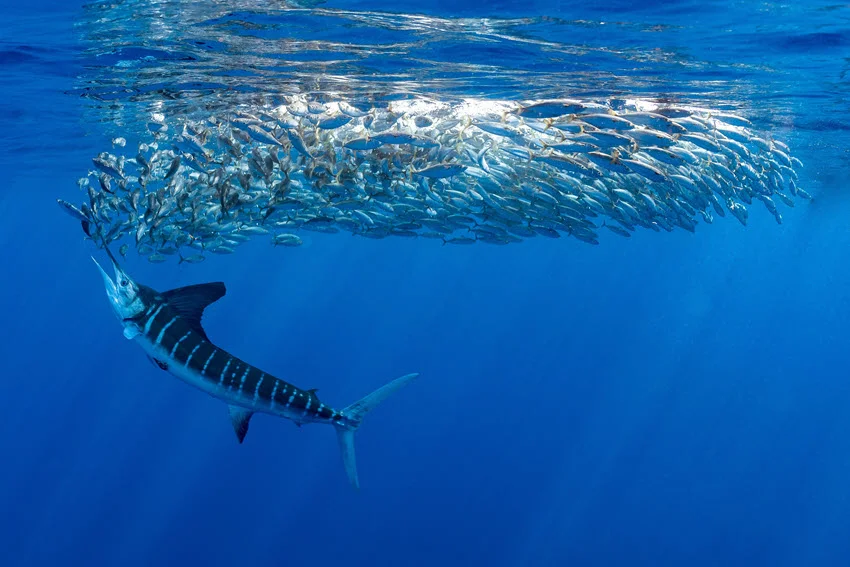
Live baiting is highly effective. It is especially successful when Marlin are feeding on specific prey. Standard live baits include Mackerel, Bonito, and squid. This method often involves slow trolling or drifting near bait schools, allowing the natural movement of the live bait to attract Marlin. Using circle hooks is recommended to ensure a higher hookup rate.
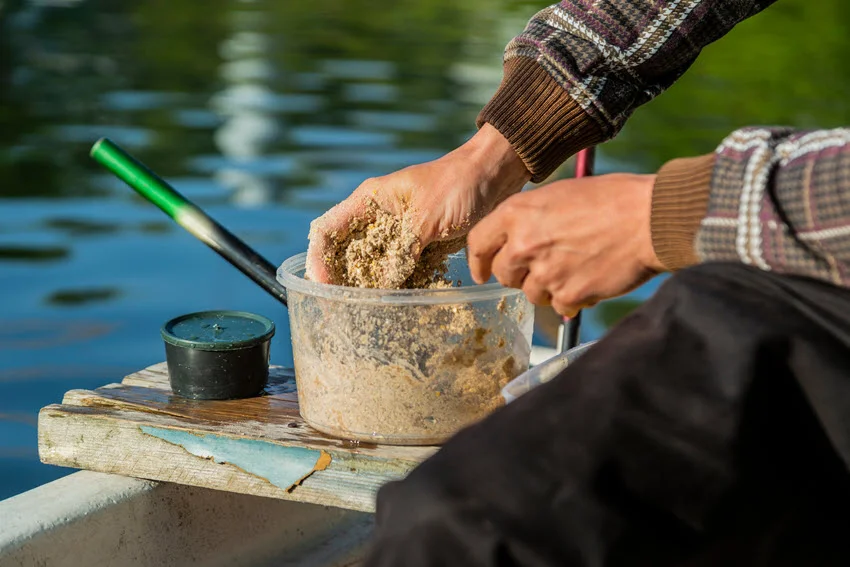
Chumming involves dispersing small pieces of bait into the water, creating a scent trail that attracts Marlin to the vicinity of your boat. Once Marlin are drawn in, anglers can present live or dead bait to entice a strike. This technique is beneficial in areas where Marlin are known to frequent but may not be actively feeding.

Kite fishing is a creative and highly visual method that keeps bait on the surface, right where Marlin love to strike. A kite flies off the side or back of the boat with a line attached to a live bait. This keeps the bait splashing and struggling on the water's surface, mimicking a distressed fish. When a Marlin attacks, the line is released from the kite clip, and the angler sets the hook. This technique works best in calm to moderate wind conditions.

Fly fishing for Marlin is one of the most challenging methods. It typically involves "teasing" the fish by dragging hookless lures or teaser chains behind the boat. Once a Marlin follows the teaser, the teaser is pulled away. The fly is quickly cast into the water in its place. Timing is critical, and precision is also important. If the Marlin takes the fly, the battle begins.

Marlins are among the ocean's most potent and aggressive predators. Enticing one to bite takes more than luck. It takes the right bait and presentation in the right way. Anglers targeting these giants rely on both artificial lures and live baits.
For many anglers, live baits are the best option for Marlin, Mackerel, Bonito, Skipjack Tuna, and small Yellowfin Tuna.
Live baits are mainly used in narrow fishing zones. They are most effective in areas where Marlin tend to gather. These are places around floating buoys or steep underwater drop-offs. Trolling slowly with live bait allows it to swim naturally in these places.
Artificial lures are a solid alternative to live baits. They are a go-to choice when covering large amounts of water. These lures mimic the movement of real baitfish. Marlin often strikes out of both hunger and aggression.
Modern Marlin lures are made in Hawaii, particularly the waters off Kona. Early innovators used anything they could find, from carved wood and glass to household items like bath towels, to create lures that would trigger strikes. Today's versions are much more refined. They are expertly balanced for trolling at specific speeds.
Lure color can make a big difference. In bright conditions, colors like blue, silver, and white work well. They reflect light and look like baitfish. Purple, black, and green are the best when the water is deeper or slightly murky.
Marlin has good vision and can see contrasts well. That's why using high-contrast color combinations often yields more effective results. Colors like pink or chartreuse can also work when visibility is low.

No matter if you want to catch smaller species or battle giants in deep offshore waters, your tackle needs to be appropriately matched. In this section, we'll look at the recommended gear for both smaller and larger Marlin.
If you're fishing for smaller Marlin, you can get away with moderately heavy tackle that still offers control without being overly bulky. A 30 to 50-pound class stand-up rod with a conventional lever drag reel will do the trick.
Most anglers spool their reels with 30 to 50-pound braided line, finishing it with a strong fluorocarbon leader for abrasion resistance and stealth. Circle hooks in the 7/0 to 9/0 size increase the chance of a safe release. A fighting belt or lightweight harness helps provide support during the fight. It's optional, depending on the fish's size.
For larger species, especially those pushing the 1,000-pound mark, you'll need to upgrade to heavy-duty big game gear. The standard is an 80 to 130-pound class rod, ideally equipped with roller guides for smoother line flow. These rods are matched with high-capacity, two-speed trolling reels.
Line setup includes 80 to 130-pound mono or braid, backed up with a leader in the 200 to 300-pound range to handle powerful strikes. Anglers opt for larger circle hooks, ranging in size from 10/0 to 12/0. Fights with big Marlin can last over an hour; a full harness setup and a fighting chair are important equipment on most big-game boats.

Understanding fishing regulations and preserving specific fish species contributes to protecting fish populations and ecosystems and promoting responsible angling practices.
Anglers Booking team
If you want to fish for Marlin, knowing which regulations apply to Marlin is imperative. These regulations have several goals. The most important is the one related to the preservation of their species. Below, we detail Marlin's rules, regulations, and licenses.
It is important to note that fishing regulations can also vary within different state regions. The U.S. government and state fisheries departments update these rules.
Marlin fishing is the ultimate test for anglers who love challenges. These giants offer exciting battles. Any type of Marlin will give you a real adventure. If you have carefully analyzed our article, you are well on your way to catching a Marlin.
And what have you experienced fishing for this fish? What is the largest specimen you have caught? Have you visited any of the places we have listed? We look forward to your comments!

The expert copywriters at Anglers Booking have meticulously crafted this article. Our dedicated team of writers provides valuable insights and information to enhance your angling experience.
Embark on unforgettable fishing adventures with us at Anglers Booking.
book your charterOctober 17, 2025
October 15, 2025
October 10, 2025
October 11, 2025
October 4, 2025
September 29, 2025
September 25, 2025
September 21, 2025

You're now part of our exclusive community. Get ready for premium content and updates straight to your inbox.
close
Subscribe to our newsletter and receive a selection of cool articles every week.
Please enter a valid email address.

Be the first to know when we're back in action.
Please enter a valid email address.
Leave a Comment
Your email address will not be published. Required fields are marked *
Thank you for your comment! It has been submitted for review and will appear on the site shortly.